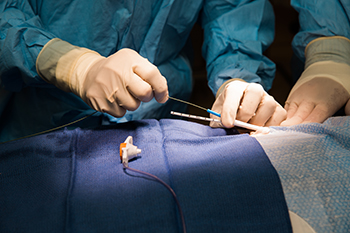News and Events
Dr. Baljepally's Innovation Impacts Cardiac Care
 Every day, physicians have to think on their feet. Sometimes, this quick thinking leads to game-changing techniques for the whole industry. This was the case when Raj Baljepally, MD, Clinical Assistant Professor of Medicine, and his medical team invented a new way of putting in a small heart pump, called an Impella device.
Every day, physicians have to think on their feet. Sometimes, this quick thinking leads to game-changing techniques for the whole industry. This was the case when Raj Baljepally, MD, Clinical Assistant Professor of Medicine, and his medical team invented a new way of putting in a small heart pump, called an Impella device.
The Impella pump sits in the left ventricle and is used to help hearts that are weak or failing to keep blood flowing to the body until the heart can recover enough to pump on its own.
Dr. Baljepally diagnoses and treats heart conditions with the help of tubes, called catheters. The catheters run from an artery in the groin or wrist into the heart. They send things like dye, or tools like the Impella, which help the medical team learn what is causing the heart to not function correctly, and to repair it when possible.
The Impella is used temporarily to keep the heart pumping until it can take over on its own. The catheter holding the device attaches to a machine at the bedside, which controls the pump. From that console the medical team can change how much the pump works. As patients recover, the team can turn down the pump and let the patient's own heart take over. Once that happens, the patient goes back into surgery and the doctors take the Impella out.
"This pump is a revolutionary method of management," said Dr. Baljepally. "You can keep blood flowing to the brain, kidneys and other organs during or after a procedure."
Dr. Baljepally and his team were working on a 45-year-old man who'd had a heart attack. They put a catheter through the patient's groin to his heart, then slid the Impella pump into place in the left ventricle. The Impella pump worked well for the first day, but as happens in a small percentage of patients, the wires of the pump kinked, which made the pump malfunction.
Scott Cook, MD, is a third-year Cardiology Fellow on Dr. Baljepally's team. He said, "When the pump stopped working, it made the patient's blood pressure crash. We knew we had to replace the pump."
The Impella pump is larger than the catheter that carries it to the heart. So when you take it out, the tube has to come out, too. This means, when the team needs to put in another device, they have to find a new place to put a catheter. The challenge is that heart patients are on high amounts of blood thinners. Using a second insertion site can cause the patient to bleed, which can be difficult to stop when the blood is so thin.
"But during this surgery," said Dr. Baljepally, "we found a new way to use the same site."
First, they took out the Impella and its catheter. Then, they placed a wire to hold open the site.
"We tried using the wire to thread in the new Impella, but the wire and the Impella's catheter together were too thick," said Dr. Baljepally. "So we discovered we could use the tubing of the Impella, itself, to slide a new catheter through," said Dr. Baljepally. "This let us put in a new device without endangering the patient with a second stick."
After the procedure, the team realized this information might be helpful for other medical teams. They went to the medical center's Simulation Lab and redid the procedure.
"We walked ourselves back through it step by step to figure out how to explain it to someone else," said Dr. Baljepally. "If other physicians learn to do this, it might help other patients, too."
Since then, Dr. Baljepally and Dr. Cook have published a paper in the medical journal, "Catheterization and Cardiovascular Interventions." As a result, the company that makes the Impella pump has started posting how-to instructions of the procedure on their consoles.
Posted November 21, 2017